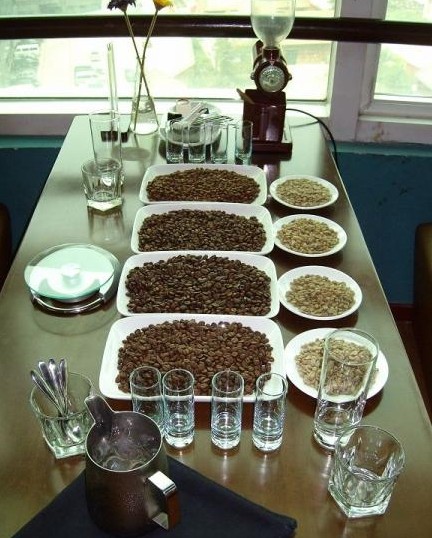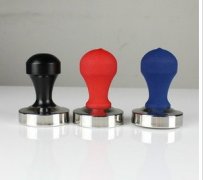The significance of coffee cup test to evaluate and compare several different kinds of coffee at the same level

The significance of the cup test is considered to be evaluating and comparing several different coffees at the same level. It is also an important course in coffee training and barista training. Because the differences between coffees are very subtle, observe the characteristics of these coffees (flavor, alcohol, freshness...) Susceptible to different coffee extraction methods. Because of the elimination of these variables, a carefully prepared cup test can taste coffee's most basic inherent characteristics.
Scientific rigor, to a certain extent, guides us to conduct accurate cup tests. Water and coffee powder measurements must be accurate, in order to prevent odor, grinding machine must be thoroughly cleaned before grinding different coffee, injection of hot water should also maintain a high degree of consistency. Time is also a factor; once the coffee powder is soaked, the brewing process begins, and in the next 20 minutes, the coffee will undergo many changes in chemistry and flavor.
From start to finish, these factors will have a very important impact on the evaluation of coffee. To ensure that every cup of coffee on the table receives the same treatment, cupping technicians have developed protocols that make preparation rigorous, regular, and orderly.
Because the purpose is different, so we do not need to do cup test at home so strict etiquette. Taking a cup test at home will show you a new world of coffee and show you what makes coffee so special to us. You'll find flavors and subtle differences that are impossible in a cup of joe tea. If you bake your own beans at home, or even if you buy a variety of individual beans, plan to put them together. The cup test allows you to evaluate and classify coffee, making you better at blending.
Cupping is also very social. Although cup tests can be done individually, cup tests are best done in groups, and you can find differences between coffee samples and your opinions and thoughts on several coffees from the comparison. For many cupping beginners, cupping with others can open your eyes and help you catch subtle hints of taste that you might have missed-your cupping partner points out something you missed, and you might find it when you taste it again. Taking cupping tests at home doesn't need to be rigorous-in fact, it means not following the rules and rituals of professional cupping tests.
If you take a cup test at home, you generally do it because you love coffee and the adventure of trying and discovering something new, or because you're just having fun. However, if your goal is to really compare the differences between different coffees, it is recommended that you be prepared to make a lot of effort from the beginning.
In the next section, we will guide you step by step on how to perform the cup test. Use these as basic tools for your cup test, but remember to be flexible. In the process of flexible application, it is even good to omit something or make some mistakes. You're about to get exposed to a real world of coffee that you already kind of like--evaluating coffee in ways you never thought possible.
Important Notice :
前街咖啡 FrontStreet Coffee has moved to new addredd:
FrontStreet Coffee Address: 315,Donghua East Road,GuangZhou
Tel:020 38364473
- Prev

Why use a coffee powder press?
Baristas all know that when using an espresso machine, the hot water brewed has about 9 atmospheric pressure (of course, this is not a fixed value, there are 12 atmospheric pressure or higher), and the pressure is very high, when the water penetrates the coffee cake. the water is inert. What is inertia, that is, water penetrates through the weakest part of the coffee cake, not from the thickest
- Next

Basic knowledge of ice drop coffee made in eight hours
Coffee shops are generally limited in supply, because each time the production time is more than eight hours, ice drop coffee originated in Europe, because the coffee distiller was invented by the Dutch, so some people call it DUTCHCOFFEE, espresso or water drop coffee. Condensation natural osmotic water pressure, up to more than 8 hours, bit by bit extraction. The taste of coffee will vary with the degree of coffee roasting.
Related
- Detailed explanation of Jadeite planting Land in Panamanian Jadeite Manor introduction to the grading system of Jadeite competitive bidding, Red bid, Green bid and Rose Summer
- Story of Coffee planting in Brenka region of Costa Rica Stonehenge Manor anaerobic heavy honey treatment of flavor mouth
- What's on the barrel of Blue Mountain Coffee beans?
- Can American coffee also pull flowers? How to use hot American style to pull out a good-looking pattern?
- Can you make a cold extract with coffee beans? What is the right proportion for cold-extracted coffee formula?
- Indonesian PWN Gold Mandrine Coffee Origin Features Flavor How to Chong? Mandolin coffee is American.
- A brief introduction to the flavor characteristics of Brazilian yellow bourbon coffee beans
- What is the effect of different water quality on the flavor of cold-extracted coffee? What kind of water is best for brewing coffee?
- Why do you think of Rose Summer whenever you mention Panamanian coffee?
- Introduction to the characteristics of authentic blue mountain coffee bean producing areas? What is the CIB Coffee Authority in Jamaica?

